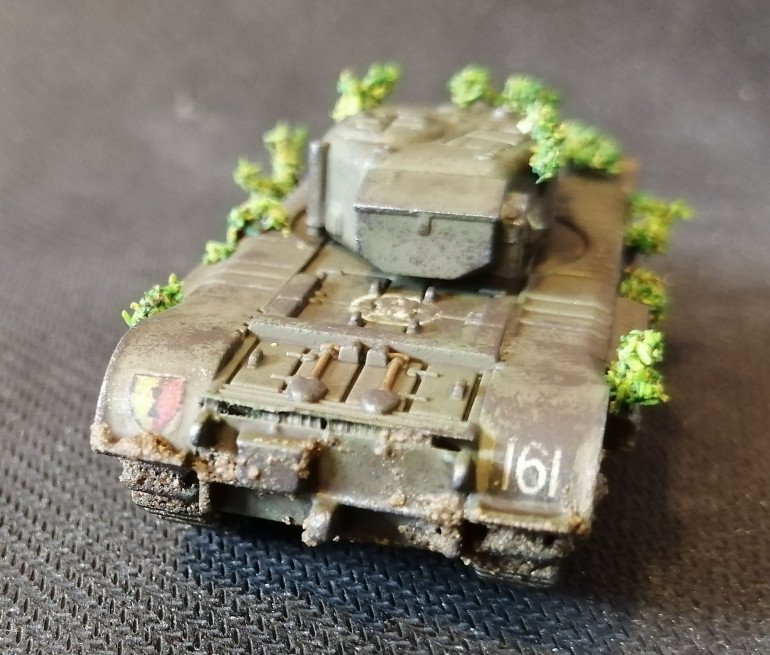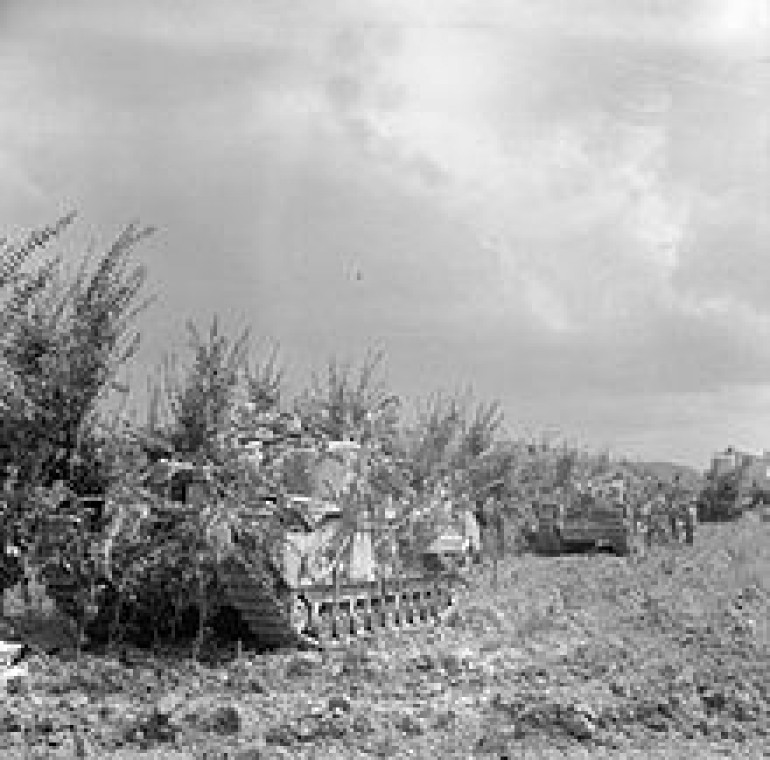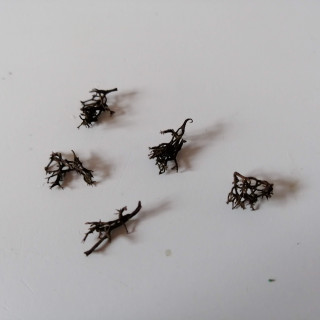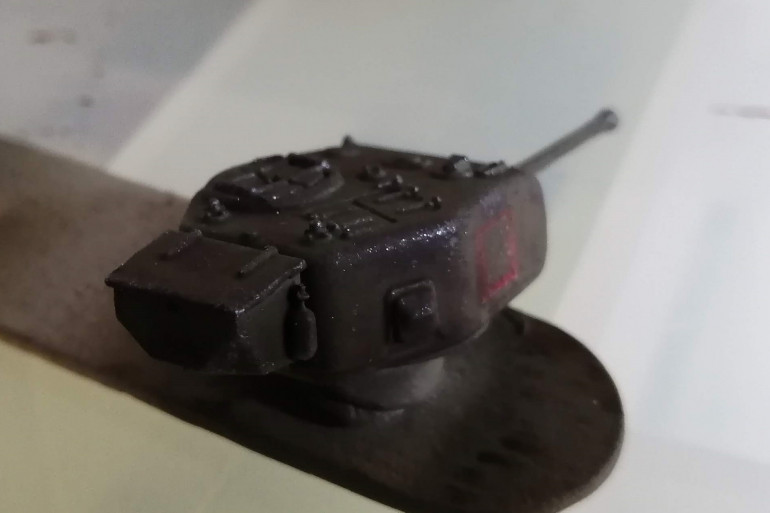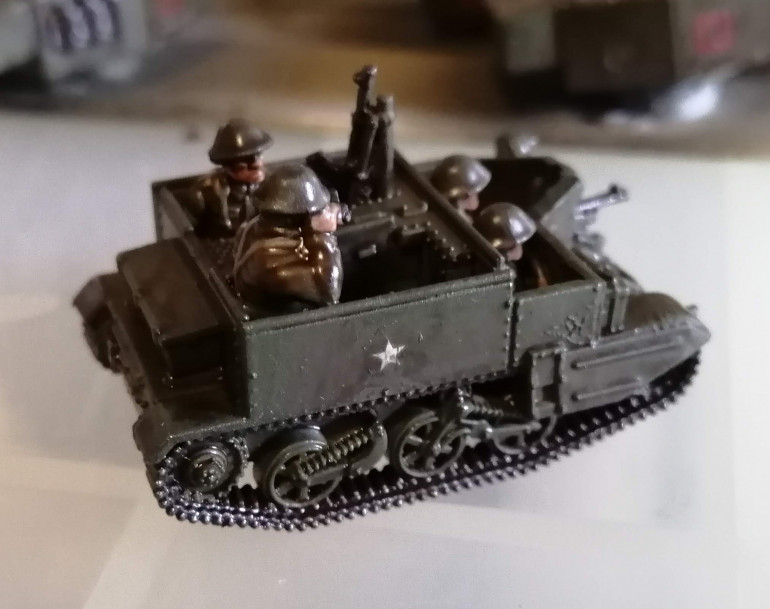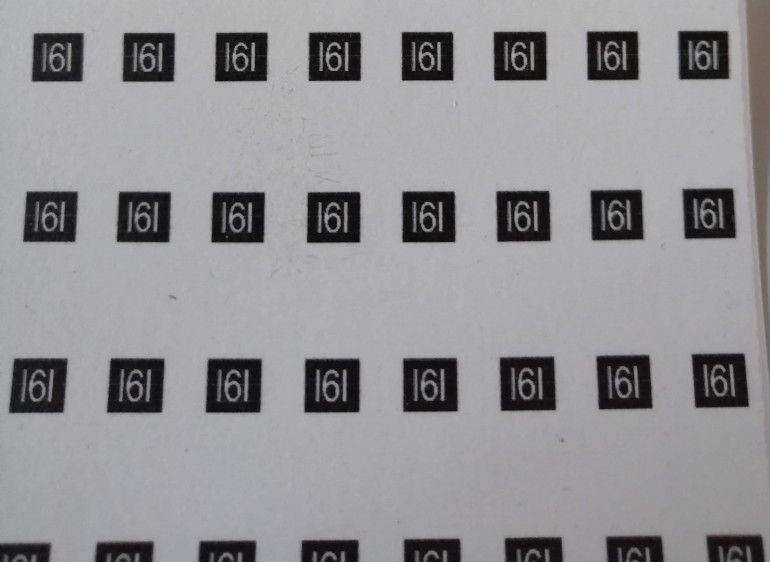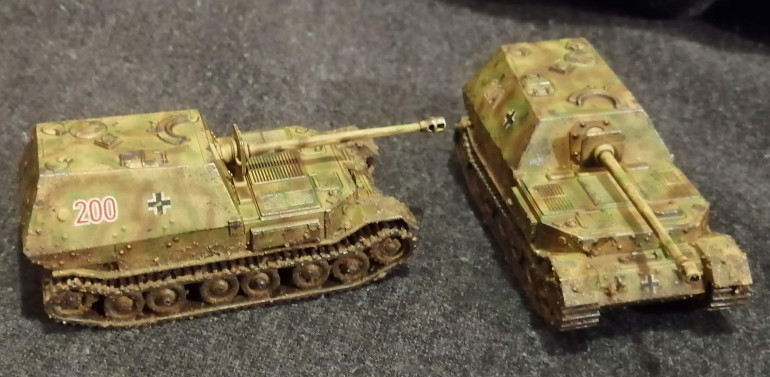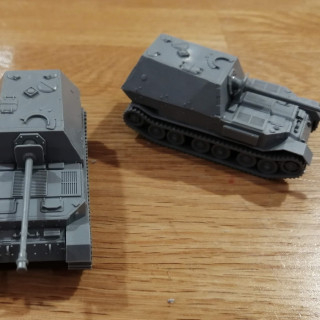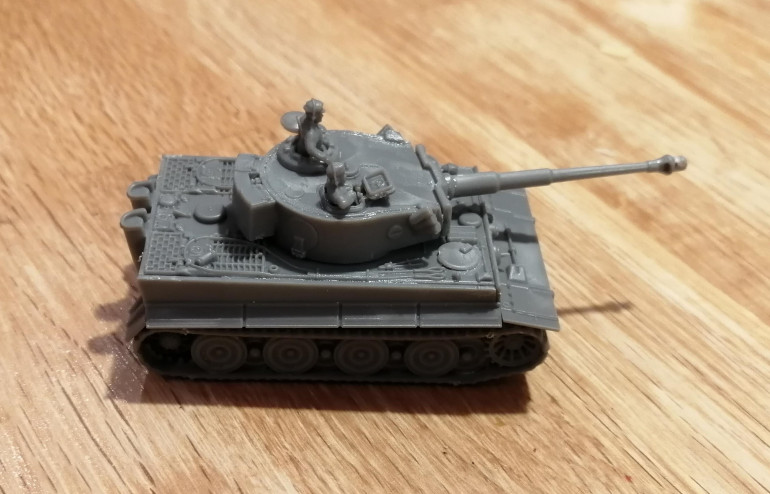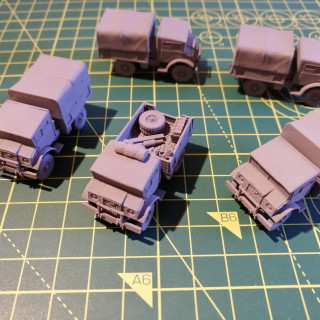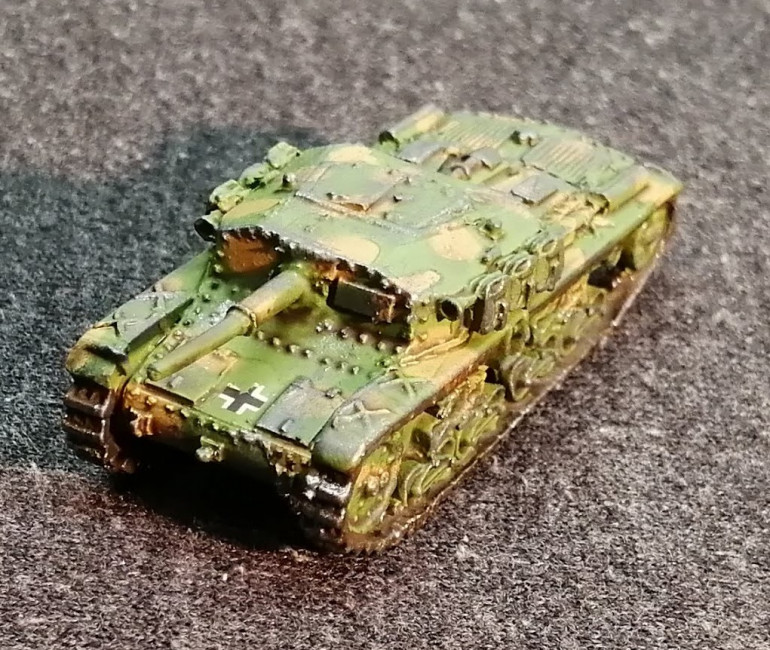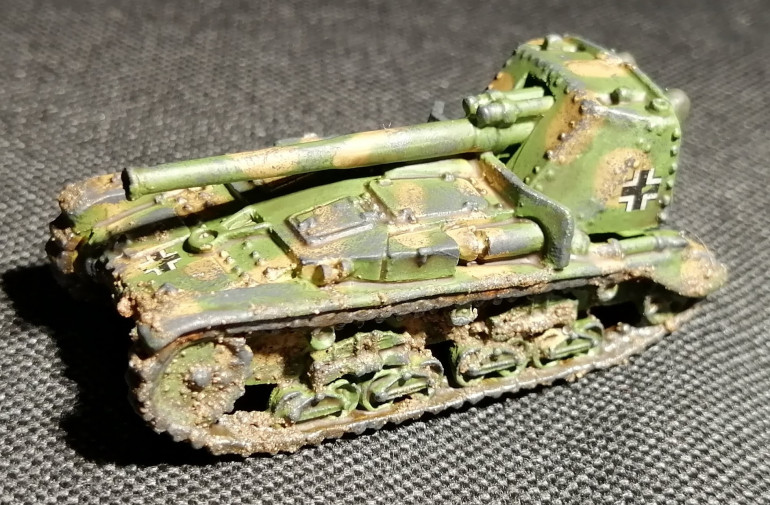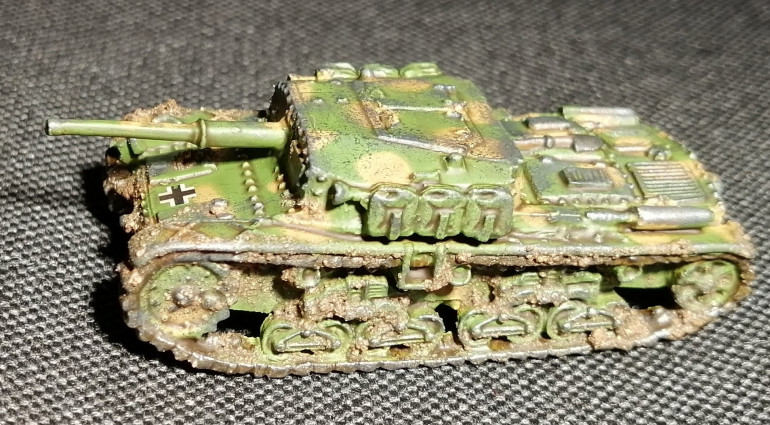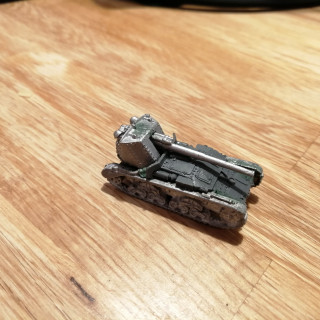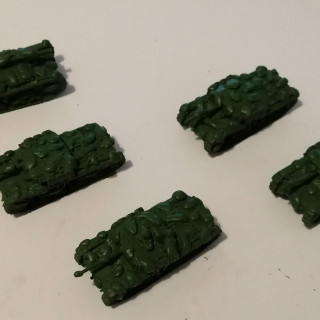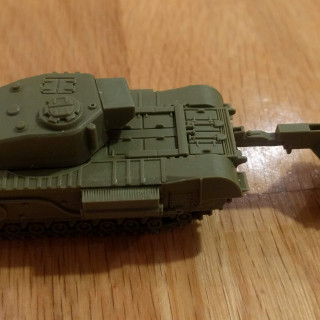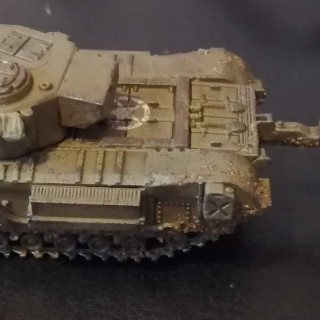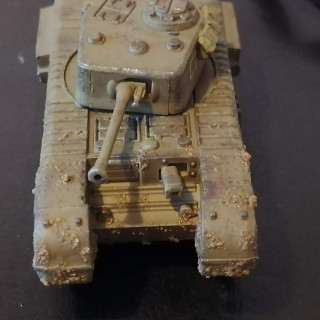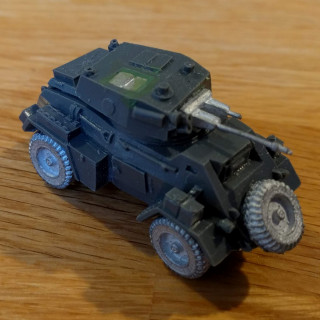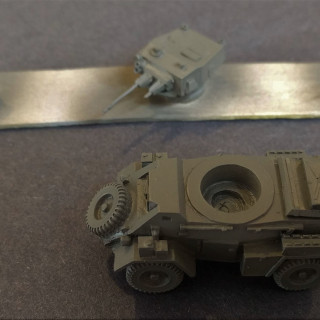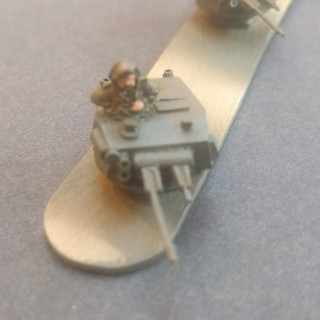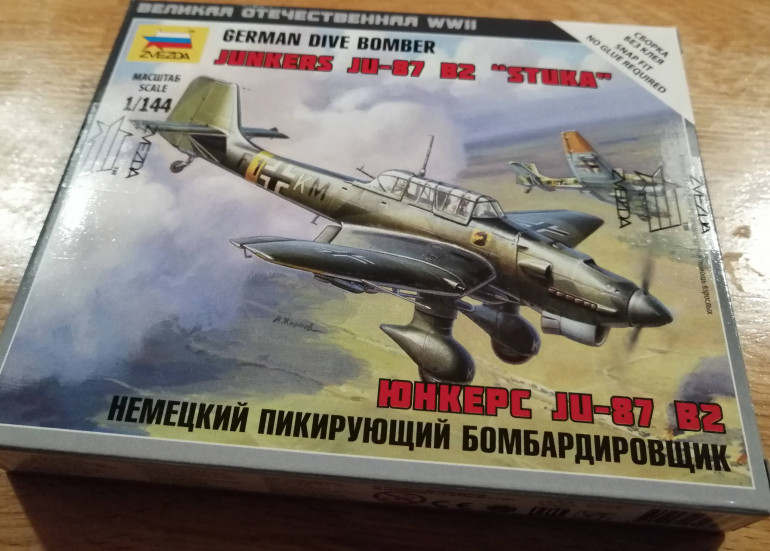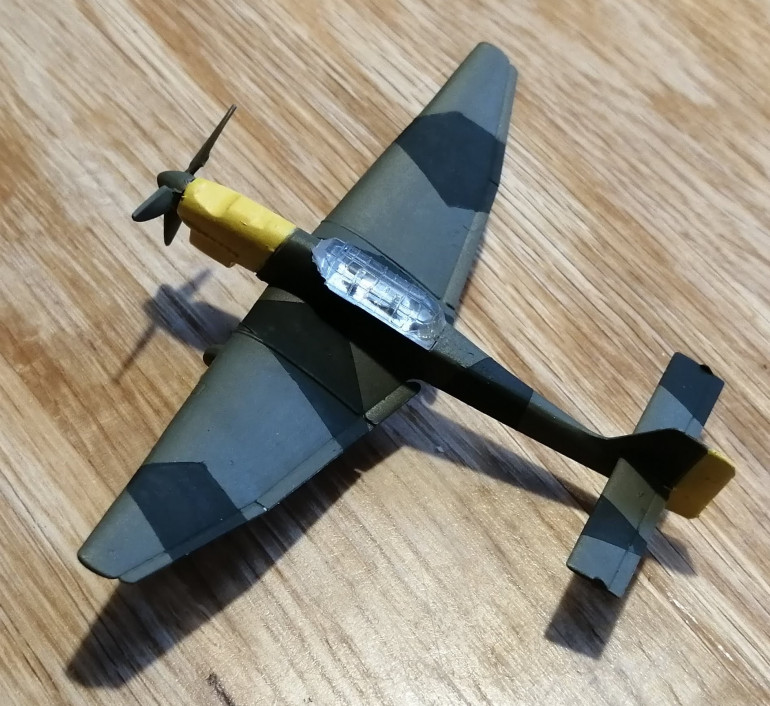
75th Anniversary of Battle of Monte Cassino and Northern Italy (Army Build)
Recommendations: 529
About the Project
This is the parallel project to my Terrain build for the Monte Cassino and Northern Italy. Here I will be painting up the miniatures to represent some of the troops that fought in the battles.
Related Game: Flames of War: The World War II Miniatures Game
Related Company: Battlefront Miniatures
Related Genre: Historical
This Project is Active
A Company of Churchills
With the chipping completed and some of the Churchills adorned with branches, I need to apply the mud. I’ve ground up some of the finest Mid Sussex Low Wealden dried mud in my pestle and mortar (see below) and mixed it up with some PVA. This just gets dabbed over where you would expect mud to land.
And then everything gets a Matt varnish to finish it off. Here’s the finished models. We have,
3 Universal Carriers with 2 MGs
3 Universal Carriers with .50 Cal MG
2 Churchill V with the 95mm Howitzer
3 Churchill III with the 6pdr gun
3 Churchill VII
7 Churchill IV with the 75mm
And a selection of turrets that can be swapped in to make up another couple of Mk VII and Mk IV
A Company of Churchills
I’ve been looking at some reference pictures of Churchill tanks in Italy and a few show the crews covering their tanks in branches, effectively making them mobile shrubberies. Here’s an example:
For a couple of the tanks (not all, there’s plenty of images of clean tanks in Italy) I’m going to try and recreate the look. I’m going to use some lichen for the branches but as this is 15mm, I’m going to need very small pieces.
The lichen is also green, so I’ll dip it into some brown paint and leave it to dry.
I then mixed up three types of fine flock of varying shades of green. With a very small brush, I applied PVA to the tips of the branches and dunked it in the flock and left it to dry.
I’ve then stuck the branches to the tanks using superglue. I will go back and apply some watered down PVA to them as well to harden them up.
A Company of Churchills
Since the last update, I’ve given everything a matt varnish to protect all the paint work so far and to remove the shine that the dip leaves. I’ve then started work on the chipping with the age old method of a bit of sponge and firstly some dark colour, in this case I used German Black Brown.
Once the dark colour was dry, I applied a gunmetal to the edges and engine decks. I wanted to achieve a fairly beat up look to emulate these tanks having been in the field for some time. I’ve probably over applied the gunmetal in some areas so I may need to go back and put a little olive drab back in.
A Company of Churchills
The Cricket World Cup has been distracting me a lot in the last couple of weeks and progress has not been as quick as I would have wanted. Besides, I’ve been finding painting 15 near identical tanks increasingly a chore but I think I’ve now broken the back of the task.
I’ve now painted on the Army Painter Dip and left it to dry. I’ve started wiping the dip off of the flat surfaces before it settles to stop it pooling and creating tide marks. Once dry, I gave everything a heavy dry brush of Reflective Green and again picked out the tools and other details. I’ve then dry brushed the tracks with gunmetal.
The next steps will be to apply a matt varnish and then get to work with the chipping and mud. But here’s where we are at the moment.
A Company of Churchills
I thought I would stick to the historical colour scheme and so I went olive drab. While the sand/black scheme looks good, I have a lot of other tanks (Shermans, Stuarts etc) already in an olive drab and doing the same here will just look better and tie in.
So I’ve now base coated everything olive drab, as you can see,
I’ve added the transfers as well. The NIH decal didn’t stand out too well against the green background so I’ve added one transfer and then applied a second over the top, which was a little fiddly. It does stand out a little better though.
I’ve also painted the detail such as the tools and skin. I’ve base coated the tracks in a burnt umber colour ready for dry brushing later in the process.
A Company of Churchills
With all of the Churchills primed and ready for painting, I have a decision to make. I already have a couple of North Irish Horse Churchills that I painted in an early Italian campaign camo pattern. This was primarily a carry over from the North Africa campaign of a desert yellow with black splotches. I like the pattern however it was only really used in 1943 and by the time 1944 had rolled around, the NIH had converted to the standard (and boring) Olive Green.
Here’s what I have already:
I can apply some poetic licence and continue with the same pattern to set my forces apart, or I could take the historical route and go Olive Green.
In the time being, I need some more NIH transfers. I’ve printed these myself onto clear transfer paper. Given that this is 15mm scale, I can get away with a fairly crude version put together in Powerpoint. Once it’s reduced in size, it should look fine. Once printed and varnished, this is what I have.
A Company of Churchills
With my batch job of German tanks completed, it’s time to turn back to the Allies and give them some more punch. My tank force is centred around the North Irish Horse and while they had Sherman tanks toward the latter part of the war, they started with a lot of Churchill tanks. So to represent this and to provide some variety, I’ve got 15 tanks and 19 turrets. This will allow me to field the 6pdr Churchill III, the Churchill CS V fitted with the howitzer, the Churchill NA75 (with the 75mm gun) and the hugely up armoured Churchill VII.
While I’m painting the Churchills, I have also added 6 Universal Carriers, three of which are fitted with a .50 Cal.
I’ll see how quickly I can get this lot painted up.
Batch Painting a Load of German Stuff
I actually finished this lot over a week ago but I’ve been away for the half term so this is the first chance I’ve had to post an update. Here are all the models completed with weathering, mud, varnished and ready for battle!
So here’s the rogues gallery of completed German Armour
Batch Painting a Load of German Stuff
Life has somewhat overtaken me recently and hobby time has gone out of the window. But, I did manage some time on me German vehicles the other day and have primed them then applied a base coat and cammo stripes. I’ve used the same method that I’ve used here on other vehicles so won’t repeat myself.
Painting on the dip with a brush is a fairly quick job and I managed to find an hour before work to do it. Below are all of the vehicles drying just before I headed off to the office smelling slightly of varnish and with some brown stains on my fingers!
Batch Painting a Load of German Stuff
I’ve managed to accumulate a number of tanks and other German bits which all needs to be painted up. So I’m going to challenge myself to paint them all in one go and see how quickly I can knock them out. I’ll be using the same methods as described previously on this project, so I won’t go into a lot of detail.
Here’s what I have
2 Elephants. These are the Zvezda kits. The first Company of the 653 Panzerjager Abteilung was deployed to Italy in February 1944 to the Anzio beach head but also took part in battles at Nettuno and Cisterna.
4 Tigers. These are the PSC kits. 508 Schwere Panzer Abteilung was a new formation when it was deployed at Anzio. It was teamed up with the Elephants and placed into 69th Panzerregiment under the Herman Goring Fallschirmjagerdivision
2 Flammpanzer III. These are the Zvezda kits. 26th PanzerDivision had an entire company of Flammpanzers in March of 1944. As they took losses, they were attached to other tank platoons as support.
2 Panzer IV/70. These are the Battlefront resin/metal kits (urgh!). These arrived much later in Italy, around October 1944 and were attached to 26th PanzerDivision.
5 8-Rad heavy scout vehicles. These are the PSC kits. 26th PanzerDivision had a few of these in their ranks.
Completing the Semoventes
Went back and completed the Semovente M42 75/34’s. Same process as before, painted on dip then a matt varnish. I’ve then re-highlighted some of the tools etc before chipping with a sponge (black/brown this time then gunmetal). Finally applied the Mid Sussex Low Weald mud and PVA mix for the mud effects. Finished with another matt varnish. Job done and they join the ranks of the Herman Goring Panzer Division (which has some really interesting lists including Panzer III’s and the ability to take 4 platoons of 88’s – I might be rolling this out at some point)
Allied Support
Rather than complete the Semovente M42 75/34’s, I thought I’d add some more to the Allied arsenal in the way of some support units. So I’ve put together 3 Wasp Flame Throwers and 5 15cwt trucks, one of which I’ve converted to a supply truck for the pioneer/engineer platoon I painted up earlier.
Here they are ready for painting.
Painting these is a lot easier than the German stuff, being largely just olive drab. Base coat of olive drab was applied with the airbrush. Once all of the other base colours were down, I’ve applied dip with a brush and then matt varnish.
I’ve kept the windows of the trucks simple and just used periscope from Panzer Aces.
Chipping and mud was applied in the same way as described in this project before. And all done – fairly easy to knock out over a few evenings.
The Wasps came from the PSC box of 9 Universal Carriers, so I still have 6 left to build. But I probably need to get the Semovente finished first, I don’t like having too many unfinished projects lying around.
Completing the Semoventes
I’ve had a lot on recently and not been able to get anywhere near as much completed as I wanted – I’m behind schedule!
To finish off the Semoventes, I’ve given them a matt varnish and then dry brushed the tracks up with a metal highlight. I’ve also gone back in to pick out the tools to give them a little more definition.
I’ve then gone straight in with the chipping – small bit of sponge with a dark grey paint followed by a metal layer, again applied with the sponge, along the edges.
Once dry, I’ve mixed up some of my Mid Sussex finest mud with PVA to apply the mud splatters. This goes along the tracks and wherever I think mud might end up. Once dry, I’ve given everything a final matt varnish.
I’ve also found out that there were a number of Semovente M42 75/34’s serving with the Herman Goring Panzer Division so I need to get these painted up in the same way. I’ve given them their base cammo pattern so they are now ready for some base colours (uniforms, tools and tracks) before the dip.
Semovente
Following the surrender of Italy, the Germans were left on their own to fight the Allies, effectively occupying Italy whilst fighting a defensive war. To supplement their forces, they took whatever equipment they could find. In the case of the 26th PanzerRegiment, this included a number of Semovente assault guns purloined from the Italian Ariete Division. They were designated StuG M42 and M43.
The Germans found these tanks to be quite effective against the Allied armour and they served within 10th Kompanie alongside a number of Flammpanzer III. During the Italian campaign, these assault guns fought mainly around the Anzio beach head however a single Semovente 90/53 tank hunter served in the battles around Orsogna before disappearing from the records.
It would be fun to have a few of these to mess around with but I’d like to put them in some Italian cammo patterns to give them a different look. So I found the below picture of a Semovente that I will try and replicate
Once again, the kits are resin and metal – not my favourite. So I’ve used green stuff to help join the metal to resin (with super glue) as this adds to the surface contact area.
I’ve then given the models a prime and base coat of dunklegelb.
To try to get the green patches, I’m going to use blue tack to mask off some areas and then use the airbrush to spray over a mid green.
So not quite the same as the picture I found but reasonably close for 15mm. Getting more patches and closer together would have been very tricky. Not sure the green is light enough but again, reasonably close and I will be weathering it up anyway.
I applied some German transfers and then gave everything a painted on army painter dip. Once this dries, I can look at the weathering.
German STuH
The German’s had a few assault guns running around in Italy including a few STuHs (like STuGs but fitted with a shorter barreled Howitzer) so I’ve put together a platoon.
A base coat of Dunkelgelb followed by some light green and medium brown lines airbrushed over create the cammo pattern – very easy to do with the airbrush. After the decals, a painted on coat of dip and matt varnish provides the depth.
Tracks were a hull red dry brushed with gunmetal.
Once again, chipping was applied with a sponge, first a black-brown paint followed by a light gunmetal on the edges.
Finally, quality low weald ground clay mixed with pva is dabbed on for the mud splatters. All covered with another coat of matt varnish to seal it all down. Quick and easy and ready for the table top.
Churchill Crocodiles
I’m adding more fire power to my British army and in this case, quite literally with three Churchill Crocodile tanks. The process for painting these was much the same as the Stuarts so I won’t go into much detail however I will focus more on the mud splatters.
Model was primed and painted British Olive Drab with the tools painted up. I’ve then applied the decals and gone for the usual mid tone dip painted on and gently dabbed off of the flat areas to stop it pooling.
I’ve dry brushed the whole model with reflective green and then just added a small highlight to the tools. Tracks were painted hull red and then dry brushed with gunmetal. I’ve then given everything a matt varnish. Straightforward so far.
Chipping was applied in the usual way with a dark grey painted sponged on and then once dry, I’ve gone back over with a lighter sponging of gunmetal.
We’re now ready for the mud splatter. I use high quality Lower Weald Sussex clay for this. Anything else is just not good enough 🙂 If anyone wants some, I’m happy to supply it at a cost 🙂
The soil must be dry and crushed down to a fine powder. You can see in the first picture below that there are a lot of lumps in mine but on the left, you can see it as a fine powder. Use a rolling pin or pestle and mortar to crush it down.
Mix a reasonable amount with PVA glue. The more glue, the less splatter once it is dry. I tend to go 50:50 and you can always add another layer if you want more.
Taking an old and very fine brush, I dab on the mixture to where I think mud could splatter. So logically more around where the tracks come up to the body and on this model, the trailer that’s likely to get a mud shower whenever the tank moves.
I’ve tried a before and after shot of the same tank here so that you can see how it dries and the effect from ‘oh crap, I’ve ruined my model’ to ‘that doesn’t look so bad’
As the PVA dries, it deposits the ground up soil into a fairly realistic splatter. This is why it needs to be ground to a fine dust otherwise the larger lumps just don’t look as natural. Once dry, you can add more layers for the really muddy look.
I’ve given my mud effect another matt varnish over the top to remove any slight shine left by the PVA and to seal the mud down. You can also carefully apply a satin or gloss varnish if you want a wet mud look.
I’m using this technique in 15mm and it works pretty well. I think if you scaled it up you would probably want to mix in some more pigments to break up the uniform brown, perhaps even add some tufts of static grass. But for 15mm table top ready, I think this looks fine.
Here’s the finished Platoon.
Alllied Support - Humbers and Stuarts - Finishing them off
With the dip applied and dry, I’ve been over everything with a matt varnish. I find the dip looks awful while shiny and you can’t see very well what you are working with until the shine has gone.
I’ve gone over the wooden handles etc again as well as dry brushing the tracks with a light gunmetal. This just helps pick out all of the detail.
I’m looking to weather these down so have taken a brown wash and applied a light wash in places more likely to be grimy as well as adding some water marks.
I’ve chipped the tanks up in the usual way. A small bit of sponge dipped in a dark brown and applied over the places where chips are most likely to occur. I’ve then gone over with gunmetal but lighter and less frequent.
To apply the mud, I have some high quality Sussex clay soil from my back garden. This is dried out and crushed down to a fine powder. I mix this with PVA and then with a very fine brush, dab on blobs where mud would collect. The PVA dries away to leave the mud behind in little clumps. At 15mm, this looks pretty good.
I’ve finally gone over with another matt varnish to seal everything in. And all done!
Allied Support - Humbers and Stuarts
So I’ve painted up plenty of German toys, time to add to the Allied arsenal. I don’t have any scouting units to deploy so now seems like a good time to do it. I’ve been shot plenty of times by Stuart’s in World of Tanks, so they must be good 🙂 and I do like the Humber IV Scout Car.
So I’ve picked up the PSC Stuart boxed set and the Humber boxed set from Battlefront.
The Humbers are a resin body with metal parts, not my favourite mix but as it was just the wheels, hatch and gun in metal, it wasn’t a big deal. I just used some green stuff to make sure there was a good contact area between the metal and resin.
The plastic Stuarts went together very easily and both vehicles have a good level of detail.
I’ve primed them with the Vallejo primer and then gone in with a Olive Drab.
Decals next. I’ve kept these simple, just some stars, British turret markings for the Stuarts and a serial number. All applied using decal set.
I’ve then given the commander a coat of British Battledress, black for any cables/headsets and barbarian flesh. Any tools have been painted flat earth for the wood and gunmetal for the metal areas. That pretty much covers the base colours – British tanks are far quicker to paint than German!
With the base colour down, I’ll now paint over these with the strong tone dip. This will provide the shading as well as locking down the decals under a varnish layer.
Junkers JU 87 - Start to finish
In my PSC box, I had ordered a Stuka. This is a simple project and as the planes don’t spend a lot of time on the table in FoW, I can spend less time on the painting. It’s a Zvezda kit and went together very easily and very quickly – it took perhaps 5 minutes to clip out, clean up and glue together!
I’ve found a nice camo pattern I want to try to copy. The underside of the plane is a very light blue. Closest from my collection is an Arctic Blue, so I’ve gone with that.
The nose area and tail fin are painted a yellow. I hate yellow, it never looks right for me so I will try the ‘build up from brown’ approach. This sort of worked. It’s better than my previous attempts but I’m still not happy with it. It still took about 10 layers of yellow just to get something resembling an even coat.
The top of the aircraft I’ve painted British Olive Drab. I’m also going to try out some new masking tape I’ve got to really try to get some clean lines on the camo.
Once I was sure the masking tape was applied properly, I’ve gone for German Camo Green, which is quite a darkish green. Seemed to match up well with the picture I had.
As I had thinned the paints down, there was a little bleeding under the masking tape, particularly where the tape crossed some of the detail but nothing too bad. It was fairly easy to clean up and the result looks far better than my freehand.
The set came with some transfers that I duly applied and then gave the model a gloss varnish.
To apply some shading, I’ve given a light dark yellow wash over the yellow areas, a trusty sepia wash on the top and a watered down dark blue for the underside. Once all dry, I’ve applied a matt varnish and it’s good to go. Quick job and table top ready!
Marder II - Going back and doing it properly
In my last update, I had decided to leave the Marders as they were and ‘table top ready’. After some thought, I decided to go back and finish them properly, so here’s the final steps.
I’ve decided to go big on the chipping, after all, these vehicles have been in the field for some time and saw plenty of action. I’ve just used the age old method of small sponge and a dark colour, in this case I went with a Dark Grey from Vallejo.
I’ve then gone back over with some gunmetal, particularly along the corners where it is more likely that all of the paint will be removed.
I applied some slight streak effects where I think water may have run down the side of the vehicle. Everything then got another matt varnish.
Finally, I mixed up some dry mud from my garden with some PVA and applied this in little splodges to where mud would have built up. And now I’ve finished!
Now that these are finished, I need to get cracking as Plastic Soldier Company had a 25% sale recently and I may have over indulged. This turned up the other day, so I have my work cut out….

































![How To Paint Moonstone’s Nanny | Goblin King Games [7 Days Early Access]](https://images.beastsofwar.com/2024/12/3CU-Gobin-King-Games-Moonstone-Shades-Nanny-coverimage-225-127.jpg)












